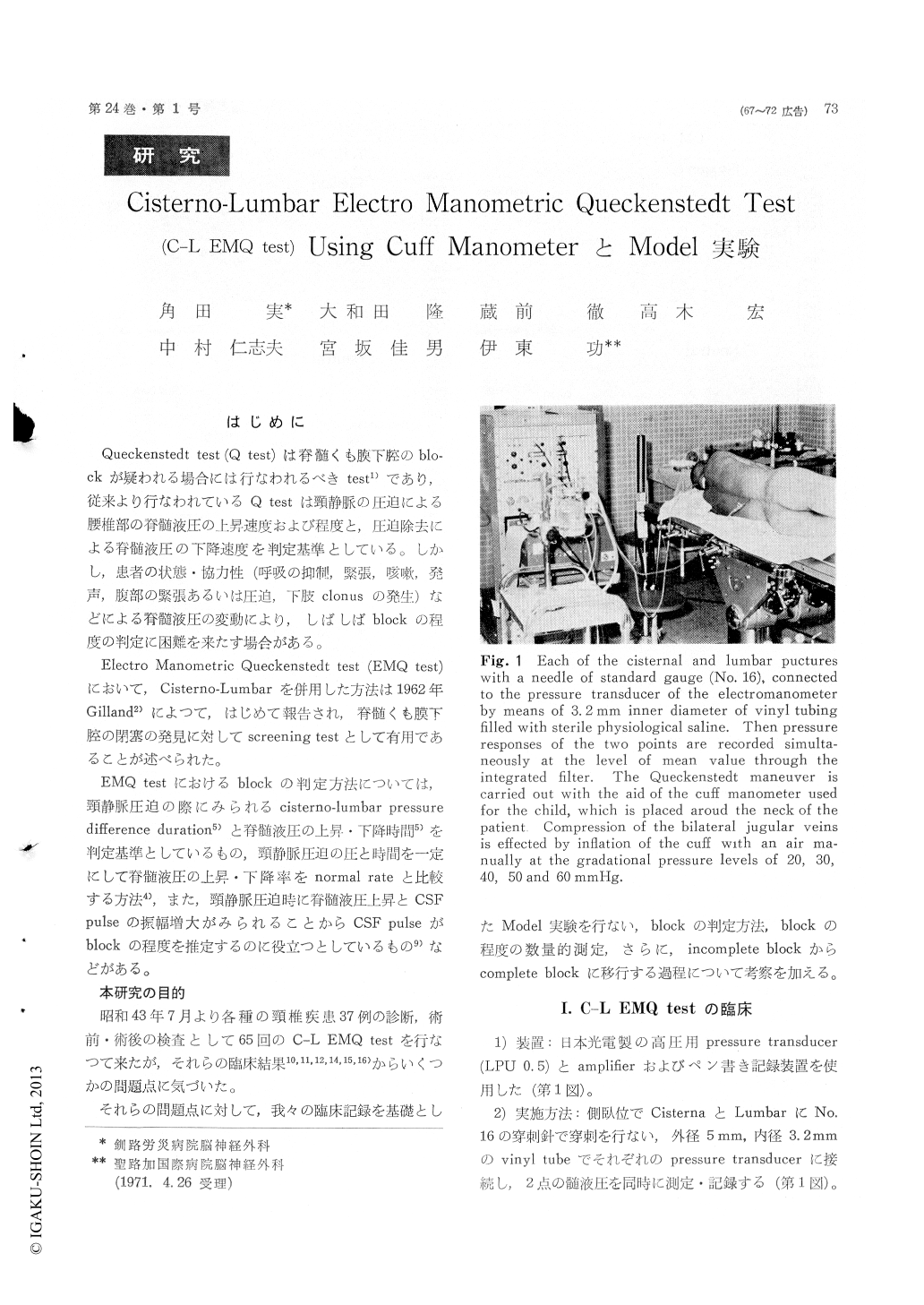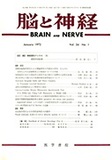Japanese
English
- 有料閲覧
- Abstract 文献概要
- 1ページ目 Look Inside
はじめに
Queckenstedt test (Q test)は脊髄くも膜下腔のblo—ckが疑われる場合には行なわれるべきtest1)であり,従来より行なわれているQ testは頸静脈の圧迫による腰椎部の脊髄液圧の上昇速度および程度と,圧迫除去による脊髄液圧の下降速度を判定基準としている。しかし,患者の状態・協力性(呼吸の抑制,緊張,咳嗽,発声,腹部の緊張あるいは圧迫,下肢clonusの発生)などによる脊髄液圧の変動により,しばしばblockの程度の判定に困難を来たす場合がある。
Electro Manometric Queckenstedt test (EMQ test)において,Cisterno-Lumbarを併用した方法は1962年Gilland2)によつて,はじめて報告され,脊髄くも膜下腔の閉塞の発見に対してscreening testとして有用であることが述べられた。
We have performed C-L EMQ Test to the 37cases, 65 times totally for recent two years and alsoperformed model C-L EMQ Test simulating theclinical condition and recording method. We couldobtain the interesting findings from clinical recordsupported by the model experiment. In this paper,we will report its clinical and experimental methodsand their results.
Clinical method: Each of the cisternal andlumber punctured needles was independently con-nectected to the pressure transducers,which recordedsimultaneously pressure responses of the two pointsunder the managements of gradational jugularcompression using cuff manometer (20,30,40,50and 60 mmHg), coughing and abdominal compres-sion in flexion, neutral and extension of the neckposition with a chart speed of 2. 5 mm/sec. (Fig. 1,2,3)
Experimental model: Each of the pressure trans-ducers was fitted to the right (cephalic) and left(lumbar) ends of the vinyl tube, the fine calibratorwas applied between them and made the stenosisof the tube. The gradational pressures simulatingthe recording results of the clinical gradationaljugular compressions were given through the pres-sure indicator of the right (cephalic) side of thistube. (Fig. 4,5,6 and Tab.1)
The clinical and experimental results are follow-ings;
1) The relationship between the degrees ofjugular compression and the raises of CSF pressureshowed a lineal equation. (Fig.2,3,5,6)
2) The degree of the narrowed pathway of thespinal subarachnoid space can be shown quantita-tively as a ratio (%) of cisternal and lumbar tri-angle dimensions, which are made up by the baseline (initial pressure line) and the line drawn toconnect with the tops of the pateau waves at thetime of gradational jugular compressions. (Fig. 2,3,5,6)
3) The C-L EMQ Test showed no block (normalfinding) in very wide range. (Fig. 5,7)
4) Once the evidence of partial block appears,the changes from patial to complete block lie inextreme narrow range. (Fig. 6,7)
Concerning with the way to decide the evidenceof spinal subarachnoid obstruction and to presentthe degrees of the partial block as a ratio(%), wethink our C-L EMQ Test using cuff manometer isunique. Because this method is based upon theconsideration including the amplitude responses,rising and falling tlmes of CSF pressure, and cis-terno-lumbar pressure difference duration duringthis recording times.

Copyright © 1972, Igaku-Shoin Ltd. All rights reserved.


